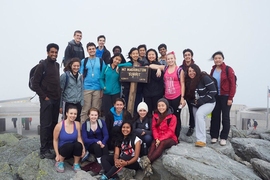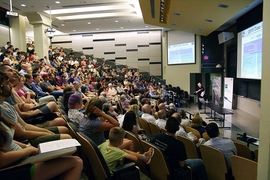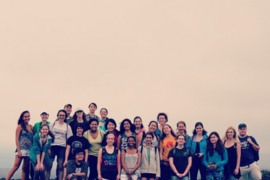The 2015 Discovering Earth, Atmospheric and Planetary Sciences (DEAPS) trip to Yellowstone and Grand Teton national parks took 19 incoming freshman and five upperclassmen on a week long Earth science adventure to the western United States last month. The trip, developed in 2005 by Department of Earth, Atmospheric and Planetary Sciences (EAPS) Professor Sam Bowring, introduces incoming students to multiple Earth science subfields and engages them with first-hand experience in the art and practice of geoscientific inquiry. The trip also seeds a community for incoming freshman to lean on as they navigate one of the biggest transitions of their lives: beginning at MIT.
Science stops on the trip focused largely on geomorphology, geobiology, and petrology. Before each day’s hikes, professors and graduate students with a variety of Earth science backgrounds led students through a group reading of the trip’s guidebook, providing background on the geological history of the areas they would be visiting and features to look out for.
The hikes were planned for their wealth of geological and intellectual diversity. For example, on a hike from Fairy Falls to Imperial Geyser in Yellowstone National Park, the students learned about erosion and the undercutting of waterfalls from graduate student Kim Huppert; about radiometric dating of volcanic rocks from graduate student Annie Bauer; and about extremophile cyanobacteria living in alkaline hot springs from Professor Greg Fournier — a whirlwind introduction to EAPS Earth science.
On another trip, the group took an aerial tram up Rendezvous Mountain in the Tetons Range to see a glacially carved valley and evidence of tectonic activity along the Teton Fault. On the way back to Yellowstone, the group stopped to check out the scar and debris from the devastating Gros Ventre landslide. They also ventured to Tuff Cliff, where the pyroclastic flow from one of Yellowstone’s enormous caldera eruptions towers above the forest below.
At night, groups presented around the fire: skits, raps, interpretative dances, and songs encapsulated and expanded on each day’s discoveries.
Learning about the deep inner workings of the Earth and the interaction of tectonics and life on its surface was new and exciting for the incoming students, but for many, the camping and hiking were equally striking parts of the trip.
The group hiked between three and 10 miles each day at elevations ranging from 6,000 to 11,000 feet and in temperatures from 30 to 90 degrees Fahrenheit. They also cooked their own meals and kept camp clean and bear-free. That is to say: The students found themselves in a variety of situations most of them had never encountered before.
“DEAPS Yellowstone was the most physically challenging yet rewarding experience I have ever had," said freshman Jenny Xue. "From speed walking up the Grand Tetons to becoming a professional garlic mincer, I [will] treasure these amazing memories as well as the friendships [I made] forever.”
Many students echoed the sentiment that the Yellowstone excursion gave a group of brilliant, funny, curious young people a way to find their first place at MIT. While college can be an isolating and scary experience, especially in the first semester, DEAPS Yellowstone — much like DEAPS Extreme Weather and Climate, the other Discover EAPS freshman program — provides students an opportunity to rattle upperclassmen for advice, and to connect with individuals in a variety of roles at the Institute.
“There is nothing quite like bonding with others who are overcoming the same challenges alongside you," said freshman Abigail Drokhlyansky. "The trip acted as an introduction into the MIT community, and it gave me the opportunity to collaborate with others for a common purpose.”
Students came away from the trip having made their first friends at MIT. They found older students to collaborate with, they got to see MIT professors as people, and they met staff members they can turn to for advice when they’re not sure where to go.
Many people worked incredibly hard on this trip, including Professor Greg Fournier, Professor Emeritus John Southard, graduate student Maya Stokes, admissions officer Brenna Heintz, and administrator Annora Borden. But this year’s incarnation of the DEAPS Yellowstone trip was made possible in large part by the intense dedication of graduate students Kim Huppert and Annie Bauer.
Thanks to these dedicated individuals, 24 MIT undergraduates trekked out into a national park and became a learning community in pursuit of geological knowledge. The 19 incoming freshman came back to Orientation Week having accomplished their first intellectual feats as MIT students and having begun to mark their place in the larger Institute community.











